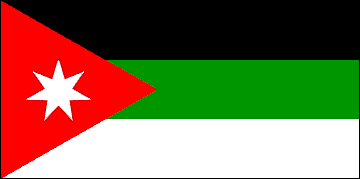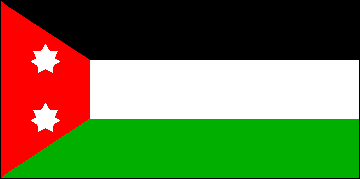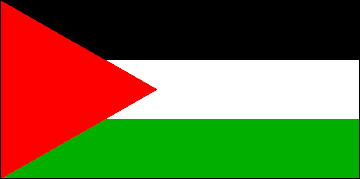Americans have—mostly to their disgust—become familiar with the Palestinian flag, which is prominently displayed by “anti-Zionist” activists who demand “justice for Palestine” by means of pillage, rape, torture and mass murder. That flag, however, once symbolized something different: the freedom and unity of the Arab peoples.
The current Palestinian flag originated as the flag of the Arab Revolt against Ottoman rule during the First World War. The revolt began on June 10, 1916, at the behest of Sherif Hussein bin Ali at Mecca. Its political aim was to throw out the Turks and create a single Arab state from Aleppo in Syria to Aden in Yemen. The Sherif also accused the Young Turks, who dominated the Ottoman government, of impiety in that many of their policies violated Islamic law. For their part, the Turks accused the rebels of betraying the Muslim Caliphate by siding with the European imperialist powers who aspired to conquer and carve up Muslim lands in their own interest. (As events would prove, the Turks had a point.)
The Revolt failed to attract widespread support, being largely confined to the Arabian Peninsula and the tribes loyal to Sherif Hussein. Arab forces to the number of some 5,000 did, however, play a useful role in support of the British campaign that led to the destruction of Ottoman power in the Middle East.
The flag of the Arab Revolt, also called the Pan-Arab Flag, was a horizontal tricolor of black, green, and white stripes with a red triangle at the hoist. These colors have long been associated with Islam and the Arabs. White and black flags were supposed to have been used by the Prophet Muhammad. Green, widely acknowledged as the color of Islam, was the traditional color of the Fatimid dynasty that ruled North Africa from the tenth to the twelfth centuries. Red is the traditional color of the Hashemite dynasty, descendants of the great-grandfather of the Prophet, and for centuries the rulers of Mecca.
Though the version shown above was the most common, some early Arab Revolt Flags had black/white/green stripes. This later became the standard design.
This flag was used by the Arab administration that was set up by the British in Damascus after the ejection of the Turks from Syria. In 1920 when an independent Kingdom of Syria was proclaimed with Sharif Hussein’s elder son, Faisal bin Al-Hussein, as king, its national flag was the Arab Revolt Flag with a large seven-pointed white star placed on the red triangle to signify independence. The kingdom, however, lasted only for a few months, the European powers having agreed that Syria should become a League of Nations mandate territory under French rule.
The first Arab country to achieve independence was Iraq, which consisted of the three Mesopotamian provinces (Mosul, Baghdad, and Basra) of the defunct Ottoman Empire. These were grouped together as a League of Nations mandate territory under British control. But the Mandate proved unpopular with the inhabitants of the three provinces, and in 1920 a revolt against the British broke out. Though soon put down, it convinced the British government to change its policy, and the Mandate was transformed into a nominally independent protectorate. The British decided that Iraq should become a kingdom, and the crown was given to Faisal bin Al-Hussein, who became King Faisal I in 1921. In 1932, the Kingdom of Iraq was formally admitted to the League of Nations. This brought the protectorate to an end, though under the terms of the Anglo-Iraqi Treaty (signed in 1930) British influence remained paramount.
The Kingdom of Iraq adopted a national flag based on the Arab Revolt Flag. King Faisal merely added two white, seven-pointed stars to the red triangle, symbolizing that Iraq was the second Arab nation to emerge from the wreckage of the Ottoman Empire—the short-lived Syrian kingdom being the first. In 1924 the design was refined. The order of the stripes was changed to black/white/green, and the red triangle became a trapezoid. This remained the national flag of Iraq until the 1958 coup that ended the monarchy. Another version of the Arab Revolt Flag, similar to the current Palestinian National Authority flag, was later adopted as the flag of the Iraqi Baath Party.
The Kingdom of Jordan originated as Emirate of Transjordan. Initially it was part of the British Mandate for Palestine, but in 1921 it was given separate status as the British Mandate for Transjordan with Abdullah bin Al-Hussein, the second son of Sharif Hussein, as emir. In 1928, the British government granted the Emirate of Transjordan full autonomy, and in 1946 the country achieved independence as the Hashemite Kingdom of Transjordan, with Abdullah as king. In 1949, having gained control of the West Bank during the Israeli War of Independence, it became the Hashemite Kingdom of Jordan.
From 1921 to 1928, Transjordan’s flag was the Arab Revolt flag with black/white/green stripes. Upon achieving full autonomy, a white seven-pointed star was placed on the red triangle, and this is still Jordan’s national flag.
Jordan is one of three Arab polities that maintain the tradition of the Arab Revolt Flag. The others are the Sahrawi Arab Democratic Republic (Western Sahara), whose flag has a red star and crescent on the white stripe, and the Palestinian National Authority. Various other Arab states have similar flags: Sudan’s, for instance, has horizontal red/white/black stripes and a green triangle at the hoist.
The Arab population of the Mandate for Palestine adopted the Arab Revolt Flag primarily as a symbol of its fierce opposition to the creation of a Jewish state on the territory of the Mandate. Simmering tensions boiled over in 1936, touching off an Arab revolt against the British authorities and the Jews that lasted until 1939. During the revolt, a variant of the flag, with a white crescent and cross on the red triangle to symbolize Arabs of the Muslim and Christian faiths, was often seen.
The Arab Revolt Flag was officially adopted by the Palestine Liberation Organization (PLO) in 1964. Following the 1967 Six-Day War, however, it was proscribed in Israel, Gaza, and the West Bank. Among the provisions of the 1993 Oslo Accords was the lifting of the ban, but its display is still restricted in Israel on grounds of national security and public order. Since 1993 in the West Bank, it has been the flag of the Palestinian National Authority (PNA).
In the post-colonial era, Pan-Arabism, the vision of a single nation embracing all Arabs, turned out to be a chimera. Neither the United Arab Republic (union of Egypt and Syria, 1958-61), the Federation of Arab Republics (union of Egypt, Syria and Libya, 1971-77), nor the Arab Federation (union of Iraq and Jordan, 1958) proved workable. Though lip service was paid to the Pan-Arab ideal, the newly independent Arab states went their own ways. And the flag that once symbolized that ideal is now the symbol of Palestinian Arab nationalism, whose core principle is the creation of a Palestinian state “from the river to the sea”—a bloody project that entails the destruction of Israel and the extirpation of the Jews.
The Hamas pogrom of October 7, 2023, gave the world a preview of how that that would look in practice—and of what the Palestinian flag now symbolizes.









